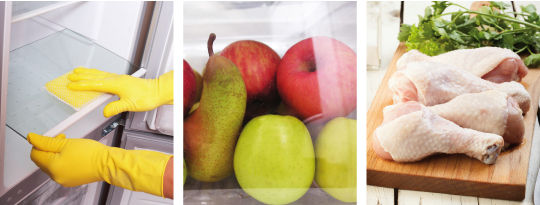Ew! What's That Smell? Organizing Your Fridge for Maximum Freshness

 The refrigerator is the workhouse of the kitchen and its busiest days are upon us. It will be required to keep the tailgating treats cold for game watching, the turkey fresh for Thanksgiving and leftovers tasty for sandwiches. It is frustrating to reach for fresh salad greens only to pull out a frozen, wilted mass. Who hasn’t opened the refrigerator door to confront a noxious fume of unknown origin? A few simple rules of thumb and some cleaning and storage hints can help keep the fresh in your food and keep funk at bay.
The refrigerator is the workhouse of the kitchen and its busiest days are upon us. It will be required to keep the tailgating treats cold for game watching, the turkey fresh for Thanksgiving and leftovers tasty for sandwiches. It is frustrating to reach for fresh salad greens only to pull out a frozen, wilted mass. Who hasn’t opened the refrigerator door to confront a noxious fume of unknown origin? A few simple rules of thumb and some cleaning and storage hints can help keep the fresh in your food and keep funk at bay.
Cool it
The goal of refrigeration is to strike the delicate balance between inhibiting bacteria growth without freezing your food. Since bacteria begin brewing around the 40 degree mark, your goal is to maintain a very narrow temperature range of 34-38 degrees.
Keeping a steady internal temperature can be tricky. It might surprise you to learn that the best way to do that is to keep your refrigerator well-stocked and full (though not stuffed). As your grocery shopping day nears and the refrigerator shelves become increasingly bare, add pitchers of water to keep things full in order to stabilize the temperature and keep your appliance working efficiently.
Clean it
Cleanliness is imperative for keeping your fridge performing well. It is time to pull it away from the wall, turn the dials to OFF and unplug your appliance. Using the brush attachment, vacuum the condenser coils, pulling off the front grille if yours are housed underneath the fridge. Go ahead and vacuum the floor under your refrigerator too, since you’ve got the opportunity. When you push the fridge back in place, be sure to leave a few inches of space behind it to promote airflow and circulation so your machine won’t overheat.
Next, take everything out, putting freezer items in coolers and refrigerated items on countertops. Remove the drawers and wash them, taking care to rinse well. The solution you use inside your fridge and freezer might encounter food, so harsh toxic chemicals are not the best choice for the job. Instead, use a solution of ½ cup baking soda mixed with 1 gallon of hot water. Wipe down all the shelves and walls, working from top to bottom.
Once the interior is sparkling, put an open box of baking soda in the back of your fridge to help absorb food odors. Remember to replace the box about every three months and don’t use this box of soda when baking or your cookies might taste like lasagna!
Store it
As you load your items back into the fridge, follow these tips to help keep food as fresh as possible:
Vegetables and Fruits go into separate drawers because they have different humidity needs. Vegetables generally need higher humidity while fruits need lower. The exception: greens don’t like extra humidity, so store them in sealed plastic bags in the low-humidity fruit drawer. Wait to wash your fruits and vegetables until right before you use them because the extra moisture and handling can cause wilting, drying and brown spots.
Note: don’t store bananas, potatoes, tomatoes, onions, garlic, lemons and limes in the refrigerator at all.
Dairy should be left in its original containers from the store. Milk should be kept in the back on the bottom shelf of your fridge, your refrigerator’s coldest spot. The same is true for yogurt, sour cream and cottage cheese.
Butter and cheese don’t particularly need a cold spot, so they can stay in the dairy compartment in the door. Once cheese has been opened, wrap it in plastic wrap or a sealable plastic bag. Likewise, most condiments have their own built-in preservatives (like vinegar and salt), so the door is a perfect spot for them. If your orange juice is pasteurized, the door is a good location for it as well. However, if it is fresh-squeezed, find a place for it next to the milk on the bottom shelf.
Believe it or not, eggs can absorb odors despite their shells, so they should be kept in their original storage cartons. Do not store them in the door; put them in the part of the fridge that maintains
the most consistent temperature: the middle shelf.
Keep all meat, fish and poultry in its original wrap, on the coldest bottom shelf. It’s a good idea to put it on a plate to catch any drips. Storing it on the bottom shelf will also shorten the distance any accidental ooze might travel!
Storing leftovers in clear, airtight containers means that labeling your leftovers is not necessary. Glass works best for things that are microwaveable.
Freezer organization is an exercise in spatial planning; you need not worry much about maximizing a frozen temperature for food preservation here (frozen is frozen). However, you should label your leftovers with the dates they enter the freezer since they will become unrecognizable long before they become inedible.
Keeping a clean, well-stocked and organized refrigerator will ensure that your kitchen’s most important appliance (and your family) will stay happy and healthy for years to come.







